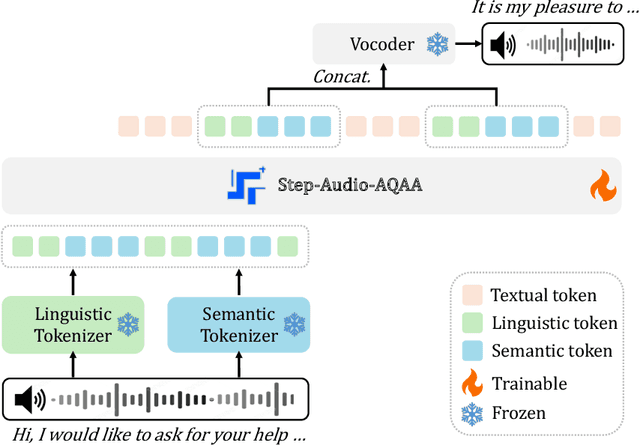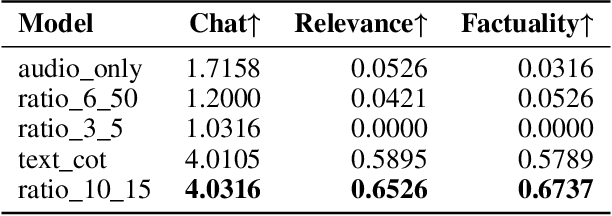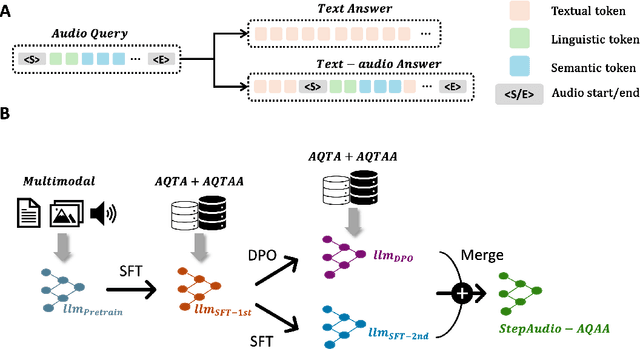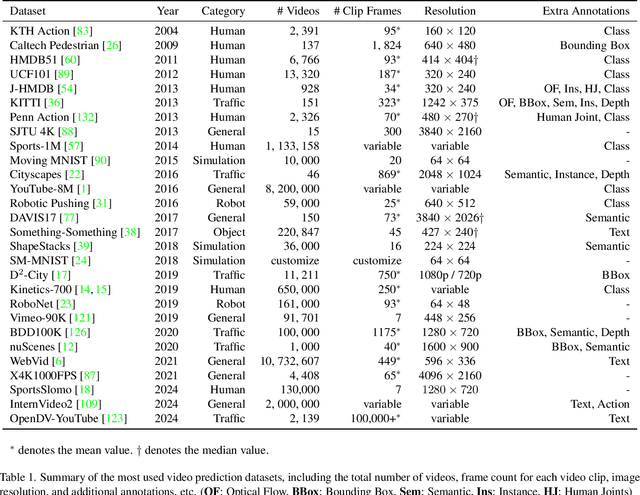Zhewei Huang
Step-Audio-AQAA: a Fully End-to-End Expressive Large Audio Language Model
Jun 10, 2025



Abstract:Large Audio-Language Models (LALMs) have significantly advanced intelligent human-computer interaction, yet their reliance on text-based outputs limits their ability to generate natural speech responses directly, hindering seamless audio interactions. To address this, we introduce Step-Audio-AQAA, a fully end-to-end LALM designed for Audio Query-Audio Answer (AQAA) tasks. The model integrates a dual-codebook audio tokenizer for linguistic and semantic feature extraction, a 130-billion-parameter backbone LLM and a neural vocoder for high-fidelity speech synthesis. Our post-training approach employs interleaved token-output of text and audio to enhance semantic coherence and combines Direct Preference Optimization (DPO) with model merge to improve performance. Evaluations on the StepEval-Audio-360 benchmark demonstrate that Step-Audio-AQAA excels especially in speech control, outperforming the state-of-art LALMs in key areas. This work contributes a promising solution for end-to-end LALMs and highlights the critical role of token-based vocoder in enhancing overall performance for AQAA tasks.
ViStoryBench: Comprehensive Benchmark Suite for Story Visualization
May 30, 2025Abstract:Story visualization, which aims to generate a sequence of visually coherent images aligning with a given narrative and reference images, has seen significant progress with recent advancements in generative models. To further enhance the performance of story visualization frameworks in real-world scenarios, we introduce a comprehensive evaluation benchmark, ViStoryBench. We collect a diverse dataset encompassing various story types and artistic styles, ensuring models are evaluated across multiple dimensions such as different plots (e.g., comedy, horror) and visual aesthetics (e.g., anime, 3D renderings). ViStoryBench is carefully curated to balance narrative structures and visual elements, featuring stories with single and multiple protagonists to test models' ability to maintain character consistency. Additionally, it includes complex plots and intricate world-building to challenge models in generating accurate visuals. To ensure comprehensive comparisons, our benchmark incorporates a wide range of evaluation metrics assessing critical aspects. This structured and multifaceted framework enables researchers to thoroughly identify both the strengths and weaknesses of different models, fostering targeted improvements.
Advancing Video Self-Supervised Learning via Image Foundation Models
May 25, 2025Abstract:In the past decade, image foundation models (IFMs) have achieved unprecedented progress. However, the potential of directly using IFMs for video self-supervised representation learning has largely been overlooked. In this study, we propose an advancing video self-supervised learning (AdViSe) approach, aimed at significantly reducing the training overhead of video representation models using pre-trained IFMs. Specifically, we first introduce temporal modeling modules (ResNet3D) to IFMs, constructing a video representation model. We then employ a video self-supervised learning approach, playback rate perception, to train temporal modules while freezing the IFM components. Experiments on UCF101 demonstrate that AdViSe achieves performance comparable to state-of-the-art methods while reducing training time by $3.4\times$ and GPU memory usage by $8.2\times$. This study offers fresh insights into low-cost video self-supervised learning based on pre-trained IFMs. Code is available at https://github.com/JingwWu/advise-video-ssl.
DialogueReason: Rule-Based RL Sparks Dialogue Reasoning in LLMs
May 11, 2025Abstract:We propose DialogueReason, a reasoning paradigm that uncovers the lost roles in monologue-style reasoning models, aiming to boost diversity and coherency of the reasoning process. Recent advances in RL-based large reasoning models have led to impressive long CoT capabilities and high performance on math and science benchmarks. However, these reasoning models rely mainly on monologue-style reasoning, which often limits reasoning diversity and coherency, frequently recycling fixed strategies or exhibiting unnecessary shifts in attention. Our work consists of an analysis of monologue reasoning patterns and the development of a dialogue-based reasoning approach. We first introduce the Compound-QA task, which concatenates multiple problems into a single prompt to assess both diversity and coherency of reasoning. Our analysis shows that Compound-QA exposes weaknesses in monologue reasoning, evidenced by both quantitative metrics and qualitative reasoning traces. Building on the analysis, we propose a dialogue-based reasoning, named DialogueReason, structured around agents, environment, and interactions. Using PPO with rule-based rewards, we train open-source LLMs (Qwen-QWQ and Qwen-Base) to adopt dialogue reasoning. We evaluate trained models on MATH, AIME, and GPQA datasets, showing that the dialogue reasoning model outperforms monologue models under more complex compound questions. Additionally, we discuss how dialogue-based reasoning helps enhance interpretability, facilitate more intuitive human interaction, and inspire advances in multi-agent system design.
Step-Audio: Unified Understanding and Generation in Intelligent Speech Interaction
Feb 18, 2025Abstract:Real-time speech interaction, serving as a fundamental interface for human-machine collaboration, holds immense potential. However, current open-source models face limitations such as high costs in voice data collection, weakness in dynamic control, and limited intelligence. To address these challenges, this paper introduces Step-Audio, the first production-ready open-source solution. Key contributions include: 1) a 130B-parameter unified speech-text multi-modal model that achieves unified understanding and generation, with the Step-Audio-Chat version open-sourced; 2) a generative speech data engine that establishes an affordable voice cloning framework and produces the open-sourced lightweight Step-Audio-TTS-3B model through distillation; 3) an instruction-driven fine control system enabling dynamic adjustments across dialects, emotions, singing, and RAP; 4) an enhanced cognitive architecture augmented with tool calling and role-playing abilities to manage complex tasks effectively. Based on our new StepEval-Audio-360 evaluation benchmark, Step-Audio achieves state-of-the-art performance in human evaluations, especially in terms of instruction following. On open-source benchmarks like LLaMA Question, shows 9.3% average performance improvement, demonstrating our commitment to advancing the development of open-source multi-modal language technologies. Our code and models are available at https://github.com/stepfun-ai/Step-Audio.
Advancing Auto-Regressive Continuation for Video Frames
Dec 04, 2024



Abstract:Recent advances in auto-regressive large language models (LLMs) have shown their potential in generating high-quality text, inspiring researchers to apply them to image and video generation. This paper explores the application of LLMs to video continuation, a task essential for building world models and predicting future frames. In this paper, we tackle challenges including preventing degeneration in long-term frame generation and enhancing the quality of generated images. We design a scheme named ARCON, which involves training our model to alternately generate semantic tokens and RGB tokens, enabling the LLM to explicitly learn and predict the high-level structural information of the video. We find high consistency in the RGB images and semantic maps generated without special design. Moreover, we employ an optical flow-based texture stitching method to enhance the visual quality of the generated videos. Quantitative and qualitative experiments in autonomous driving scenarios demonstrate our model can consistently generate long videos.
Recent Advances in Attack and Defense Approaches of Large Language Models
Sep 05, 2024Abstract:Large Language Models (LLMs) have revolutionized artificial intelligence and machine learning through their advanced text processing and generating capabilities. However, their widespread deployment has raised significant safety and reliability concerns. Established vulnerabilities in deep neural networks, coupled with emerging threat models, may compromise security evaluations and create a false sense of security. Given the extensive research in the field of LLM security, we believe that summarizing the current state of affairs will help the research community better understand the present landscape and inform future developments. This paper reviews current research on LLM vulnerabilities and threats, and evaluates the effectiveness of contemporary defense mechanisms. We analyze recent studies on attack vectors and model weaknesses, providing insights into attack mechanisms and the evolving threat landscape. We also examine current defense strategies, highlighting their strengths and limitations. By contrasting advancements in attack and defense methodologies, we identify research gaps and propose future directions to enhance LLM security. Our goal is to advance the understanding of LLM safety challenges and guide the development of more robust security measures.
A Survey on Video Prediction: From Deterministic to Generative Approaches
Jan 31, 2024

Abstract:Video prediction, a fundamental task in computer vision, aims to enable models to generate sequences of future frames based on existing video content. This task has garnered widespread application across various domains. In this paper, we comprehensively survey both historical and contemporary works in this field, encompassing the most widely used datasets and algorithms. Our survey scrutinizes the challenges and evolving landscape of video prediction within the realm of computer vision. We propose a novel taxonomy centered on the stochastic nature of video prediction algorithms. This taxonomy accentuates the gradual transition from deterministic to generative prediction methodologies, underlining significant advancements and shifts in approach.
Scale-Adaptive Feature Aggregation for Efficient Space-Time Video Super-Resolution
Oct 26, 2023Abstract:The Space-Time Video Super-Resolution (STVSR) task aims to enhance the visual quality of videos, by simultaneously performing video frame interpolation (VFI) and video super-resolution (VSR). However, facing the challenge of the additional temporal dimension and scale inconsistency, most existing STVSR methods are complex and inflexible in dynamically modeling different motion amplitudes. In this work, we find that choosing an appropriate processing scale achieves remarkable benefits in flow-based feature propagation. We propose a novel Scale-Adaptive Feature Aggregation (SAFA) network that adaptively selects sub-networks with different processing scales for individual samples. Experiments on four public STVSR benchmarks demonstrate that SAFA achieves state-of-the-art performance. Our SAFA network outperforms recent state-of-the-art methods such as TMNet and VideoINR by an average improvement of over 0.5dB on PSNR, while requiring less than half the number of parameters and only 1/3 computational costs.
A Dynamic Multi-Scale Voxel Flow Network for Video Prediction
Mar 24, 2023Abstract:The performance of video prediction has been greatly boosted by advanced deep neural networks. However, most of the current methods suffer from large model sizes and require extra inputs, e.g., semantic/depth maps, for promising performance. For efficiency consideration, in this paper, we propose a Dynamic Multi-scale Voxel Flow Network (DMVFN) to achieve better video prediction performance at lower computational costs with only RGB images, than previous methods. The core of our DMVFN is a differentiable routing module that can effectively perceive the motion scales of video frames. Once trained, our DMVFN selects adaptive sub-networks for different inputs at the inference stage. Experiments on several benchmarks demonstrate that our DMVFN is an order of magnitude faster than Deep Voxel Flow and surpasses the state-of-the-art iterative-based OPT on generated image quality. Our code and demo are available at https://huxiaotaostasy.github.io/DMVFN/.
 Add to Chrome
Add to Chrome Add to Firefox
Add to Firefox Add to Edge
Add to Edge